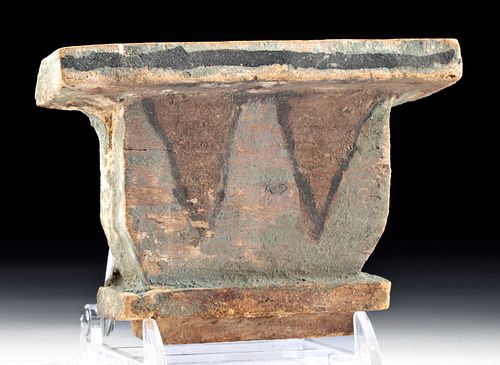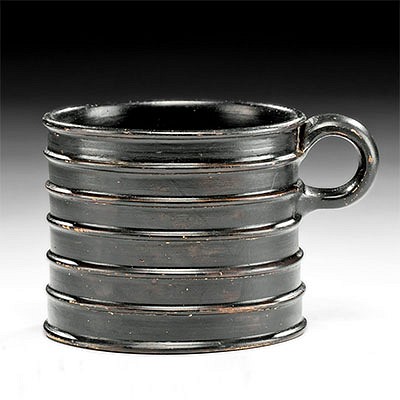Egyptian Wood & Painted Gesso Pillar Capital
Lot 6c
About Seller
Artemis Gallery
686 S Taylor Ave, Ste 106
Louisville, CO 80027
United States
Selling antiquities, ancient and ethnographic art online since 1993, Artemis Gallery specializes in Classical Antiquities (Egyptian, Greek, Roman, Near Eastern), Asian, Pre-Columbian, African / Tribal / Oceanographic art. Our extensive inventory includes pottery, stone, metal, wood, glass and textil...Read more
Categories
Estimate:
$600 - $900
Absentee vs Live bid
Two ways to bid:
- Leave a max absentee bid and the platform will bid on your behalf up to your maximum bid during the live auction.
- Bid live during the auction and your bids will be submitted real-time to the auctioneer.
Bid Increments
| Price | Bid Increment |
|---|---|
| $0 | $25 |
| $300 | $50 |
| $1,000 | $100 |
| $2,000 | $250 |
| $5,000 | $500 |
| $10,000 | $1,000 |
| $20,000 | $2,500 |
| $50,000 | $5,000 |
| $100,000 | $10,000 |
| $200,000 | $20,000 |
About Auction
By Artemis Gallery
Mar 12, 2020
Set Reminder
2020-03-12 10:00:00
2020-03-12 10:00:00
America/New_York
Bidsquare
Bidsquare : Ancient / Ethnographic Around The World
https://www.bidsquare.com/auctions/artemis-gallery/ancient-ethnographic-around-the-world-4957
Ancient art from Egypt, Greece, Italy and the Near East, as well as Asian, Fossils, Pre-Columbian, Native American, African / Tribal / Oceanic, Spanish Colonial, Russian Icons, Fine art, much more! Artemis Gallery info@artemisgallery.com
Ancient art from Egypt, Greece, Italy and the Near East, as well as Asian, Fossils, Pre-Columbian, Native American, African / Tribal / Oceanic, Spanish Colonial, Russian Icons, Fine art, much more! Artemis Gallery info@artemisgallery.com
- Lot Description
Egypt, Late Dynastic to Ptolemaic period, ca. 664 to 30 BCE. A hand-carved wooden pillar capital that was perhaps once part of an elaborate funerary offering or included as part of a coffin or sarcophagus. The capital features a broad top plinth and a narrower lower platform, with a rectangular midsection that tapers slightly along the lower corners. The entire sculpture is first covered in white gesso and painted with a palette of vibrant colors that form a three-leaf, blue-grey lotus flower atop an orange-brown base. The top plinth bears a horizontal black stripe across the blue-painted surfaces. Dowel holes on the top and bottom still retain most of their original dowels and illustrate how this component would have connected to a larger scene or structure. Lucite display stand for photography purposes only. Size: 5" W x 3.6" H (12.7 cm x 9.1 cm)
Provenance: private J.H. collection, Beaverton, Oregon, USA, acquired between 2015 and 2016; ex-private Montrose, California, USA collection
All items legal to buy/sell under U.S. Statute covering cultural patrimony Code 2600, CHAPTER 14, and are guaranteed to be as described or your money back.
A Certificate of Authenticity will accompany all winning bids.
We ship worldwide and handle all shipping in-house for your convenience.
#153864This is a component of a larger wooden sculpture. Minor nicks to top, midsection, base, and remaining dowels, with chipping and light fading to original pigment remains, and a few stable hairline fissures, otherwise intact and very good. Light earthen deposits and great remains of original pigment throughout.Condition
- Shipping Info
-
All shipping is handled in-house for your convenience. Your invoice from Artemis Gallery will include shipping calculation instructions. If in doubt, please inquire BEFORE bidding for estimated shipping costs for individual items.
-
- Buyer's Premium



 EUR
EUR CAD
CAD AUD
AUD GBP
GBP MXN
MXN HKD
HKD CNY
CNY MYR
MYR SEK
SEK SGD
SGD CHF
CHF THB
THB















